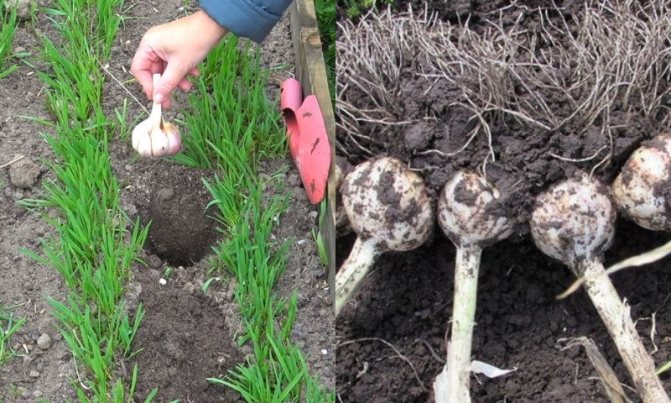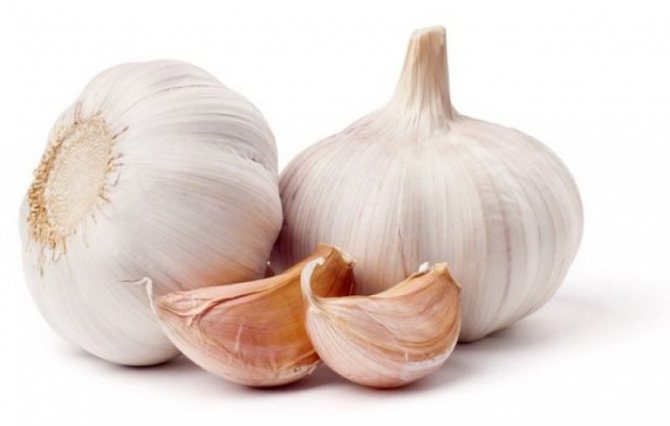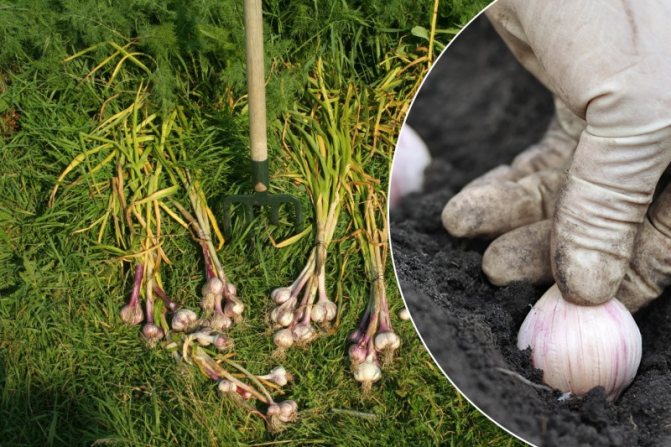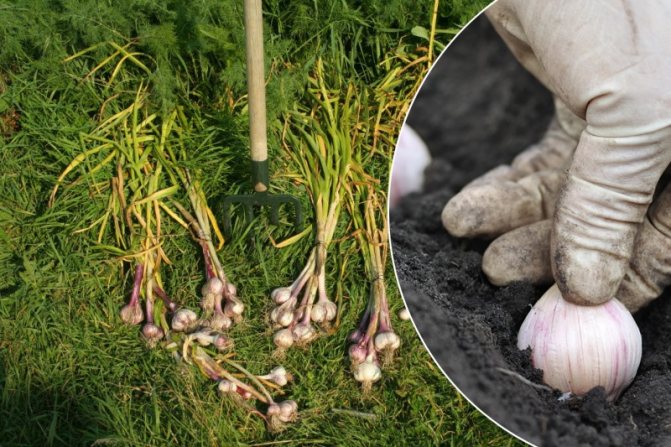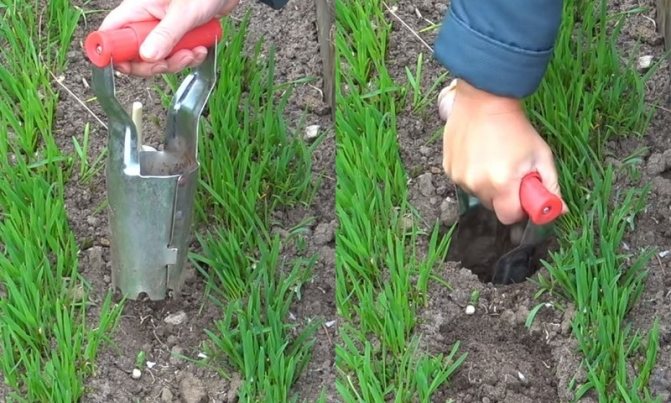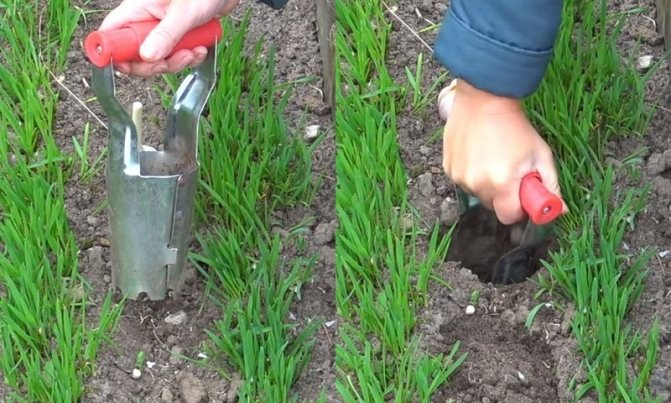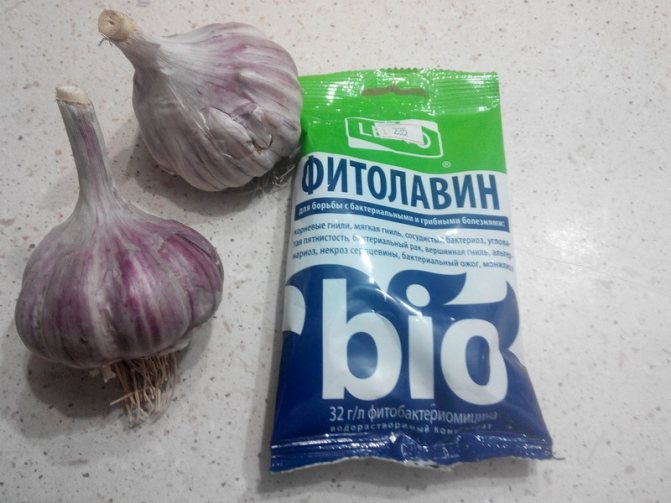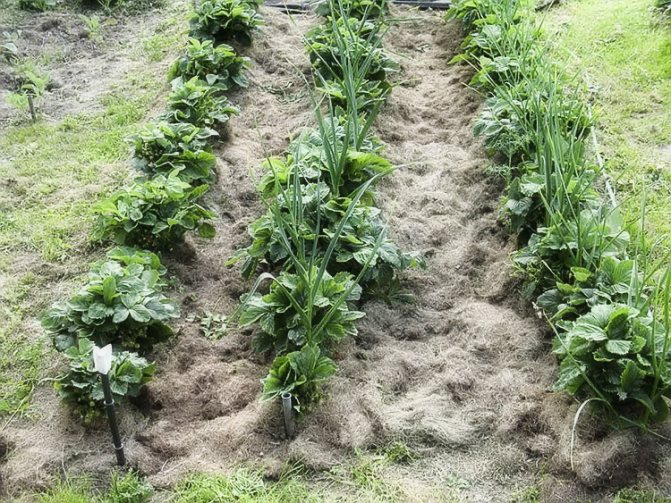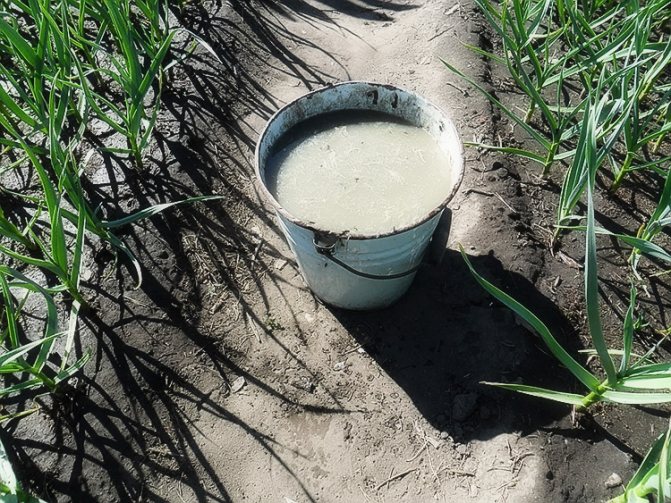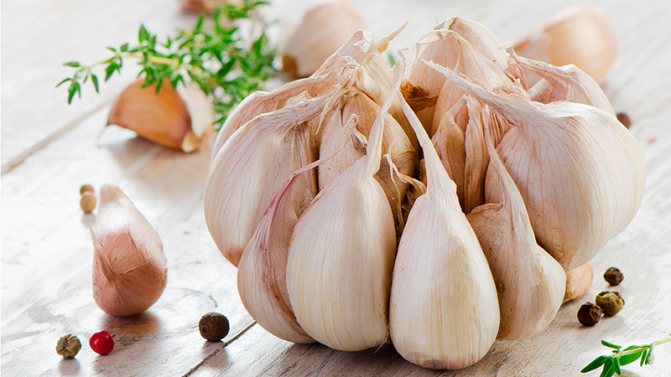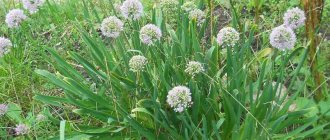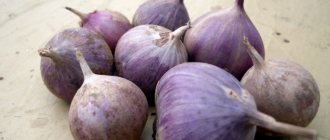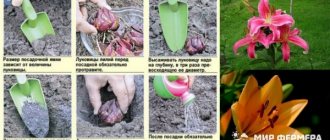The traditional way of planting garlic, which all gardeners know about, is planting with cloves. That is, you divide the head of garlic into cloves, select the best ones and plant in October, if we are talking about winter garlic.

<>
Winter garlic can be planted not only with individual cloves, but also with whole heads. This method can be called lazy, since the landing time, in comparison with the usual method, will take you very little.
Description of the variety
Any type of plant can be planted with heads. Some gardeners pass on special garlic from hand to hand. When grown in a nest, larger heads are obtained. But the name of the plant is not disclosed. Most likely, this is an ordinary zoned variety that is planted in this way. When placed in separate prongs, a typical head is obtained.
Planting a winter plant is successful. After the snow melts, clumps of green arrows sprout from the ground. Gardeners undermine them from the edges and diversify the dacha menu.
A spring vegetable is also planted whole. This saves space in the beds. Garlic tops grow tighter and rougher. But the underground part is better preserved.
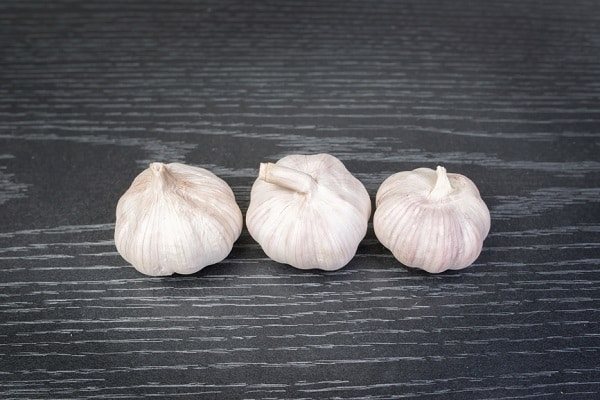

The process of propagation of garlic bulbs
Bulbules are used for growing one-toothed. They are obtained from the air capsules that form on the discarded garlic arrow. The bulbs are planted in the same way as ordinary cloves:
- a distance of 1-2 cm is maintained between individual seeds;
- up to 45-50 teeth can be arranged in each row.
The ideal hole depth is 5-7 cm. The bottom is covered with sand. The planted planting material is sprinkled with a small amount of compost.
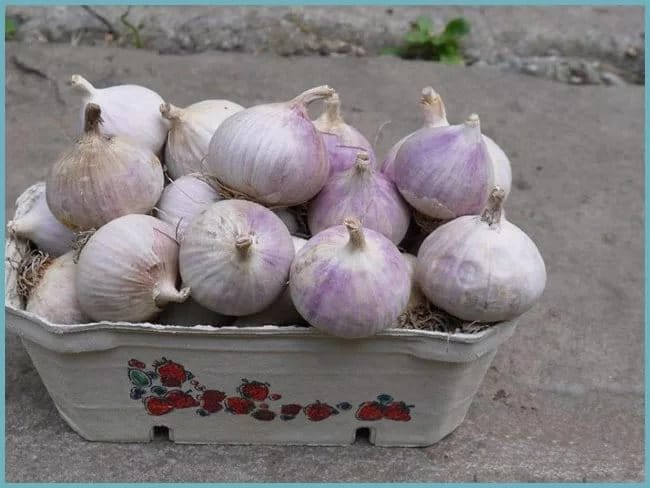

Garlic variety Lyubasha
Growing
Winter garlic with heads must be planted 10-15 days before the onset of the first frost. For the middle lane, this is the end of September or the first decade of October. The teeth should have time to take root, but not give green sprouts. So the plant will winter comfortably.
To get a good harvest, you should adhere to simple rules:
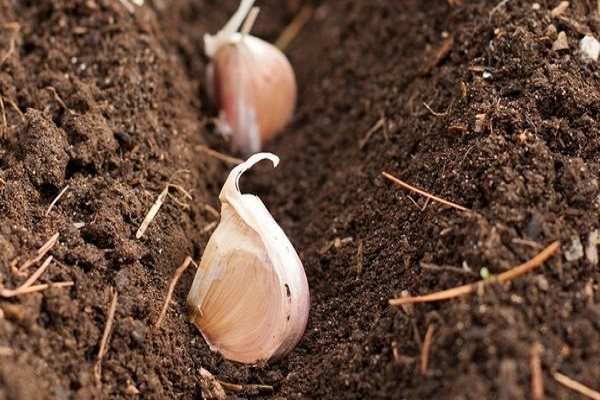

- The plant is not afraid of frost, but it gets wet easily. The gardener needs to choose a place that is not flooded with spring water.
- Mice eagerly eat heads of garlic without food. It is recommended to protect the ridges from below and from the sides with a fine mesh.
- In regions with cold winters, cover the winter plantings with white non-woven fabric. It needs to be removed after the snow melts.
See also
Description of the variety of garlic Dobrynya, features of cultivation and careRead
Spring garlic is planted with heads as soon as the ground thaws. When planting, add the full mineral complex (nitrogen: potassium: phosphorus). If it is absent, use ash (glass per square meter).


Why did garlic grow in one head? Why garlic hasn't split into cloves
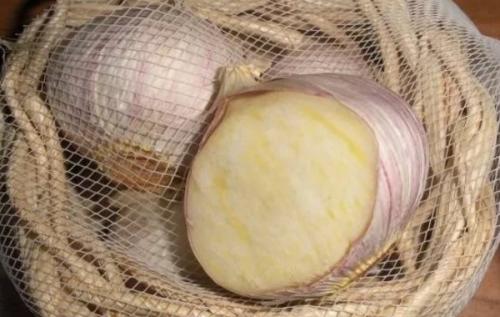

Find out why the garlic did not split into cloves and did not split into cloves - we will give two main reasons. In other cases, the landing technique is to blame.
You can tell if the garlic is ripe by looking at the head of the garlic. We dig out one head of garlic, and try to press it a little, if the head of garlic does not divide into cloves, then the garlic is not yet ripe. Therefore, the conclusion is unambiguous:
- The head of garlic has not divided into cloves because it is too early.
- Unripe garlic is divided into cloves only with the use of efforts from the hands of a person.
Why did garlic grow without cloves?
There are two main reasons:
- he is not ripe;
- not dry after collection.
Why garlic didn't form a head
There are several reasons why the garlic did not form a head:
- The most obvious is that he "went to the arrow", to prevent this, you need to remove the arrows in time. Many people tie a feather in a knot for this, but it is better to just pinch it while it is just starting to rise. Plus, young shoots of garlic are delicious.
- In addition, the problem with the formation of the head can arise due to a lack of feeding. in the ground. Make sure there is enough nitrogen fertilizer and soil looseness.
Review of Maria - amateur gardener
In June of last year, there was a very hot, dry weather for almost three weeks. In those areas where the garlic was watered infrequently and irregularly, its “neck” began to dry out (people say “the pipe has dried up”). As a result, the plants sharply slowed down their growth and development. The rainy weather in July partially saved him: the excess moisture in the air and soil allowed the garlic, albeit slowly, to continue growing throughout the month. Although we got solid heads, they are rather large. The growing season of spring garlic stopped almost a month and a half earlier than usual.
Today, too, moisture is clearly not enough. Do not repeat last year's mistake, dear gardeners!
Garlic, like onions, has a fibrous root system, which is located in the surface layer and cannot draw water and nutrients from the deep layers of the soil.
And a few more tips. Garlic requires early planting. In the last decade, weather conditions have developed in such a way that garlic can and should be planted in April, at least on May 1-2. Do not spare fertilizers for garlic!
A few words about winter garlic. Break out the arrow on it (and repeatedly), then the head will be twice as large. Well, if you need to collect seeds, leave the arrows at a few of the strongest plants.
Care features
Caring for garlic that is planted with whole heads is no different from caring for a regular vegetable. Recommended:
- comply with the landing dates;
- choose well-drained, moisture and air permeable soils;
- loosen several times per season (at least 2-3 times);
- apply the mineral complex at least once (when planting);
- break out arrows (they weaken the underground part of the plant).
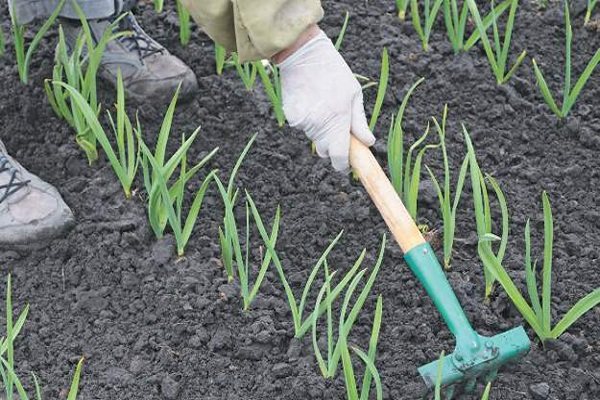

Care should be taken when choosing a landing site. The best neighbors are strawberries and fruit trees. You should not place the beds after onions, garlic, bulbous flowers.
Garlic heads do not like excess organic matter: only mature compost or humus should be applied in moderation... Pour a bucket per square meter under the digging. The ridges are fertilized 5 days before planting.
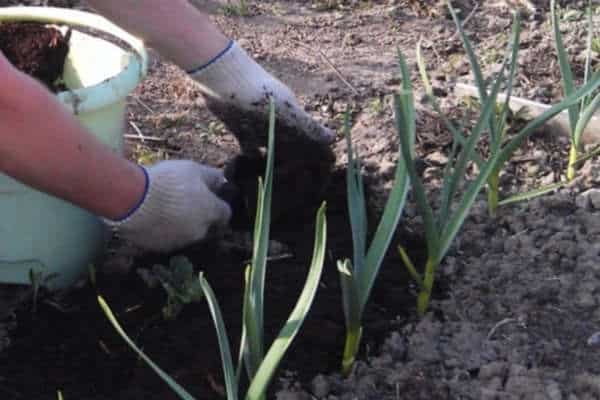

Soil requirements
For the family variety, it is recommended to prepare light, non-acidic and mineral-rich soil. For growing family garlic, heavy and sandy soils are absolutely not suitable. To increase the fertility of the soil, it is fertilized:
- add clay to the sandy soil, or vice versa, add sand to the clay soil. Consumption in both variants is up to 3 buckets of the missing component per 1 sq. M of planting area;
- reduce acidity by adding limestone. It is advisable to do this one year before planting the garlic cloves.
Advantages and disadvantages
The whole garlic cultivation has its supporters and opponents. The first point out:
- saving space;
- unpretentiousness;
- identity of taste with an ordinary plant;
- benefit of neighboring crops from regular loosening and fertilization.
Opponents talk about small bulbs and difficulties with harvesting.During ripening, you have to dig in a bush from the edges and choose small bulbs. With moderate consumption of the spice plant, you can always make some planting space.


Pests and diseases
The plant is easily affected by rot and mold during excessive watering or in rainy summers. The introduction of immature organic matter contributes to disease. Avoiding diseases and growing a good harvest will allow competent planting and care.
Garlic planted whole is damaged by an onion fly. She lays eggs at the top of the plant. To prevent loss of yield, it is recommended to adhere to the rules for the circulation of vegetable crops.
The years of the pest should be tracked. In case of large-scale lesions, the use of insecticides is required.
See also
When and how to properly trim the arrows of garlic: what does it give and is it necessary? Read
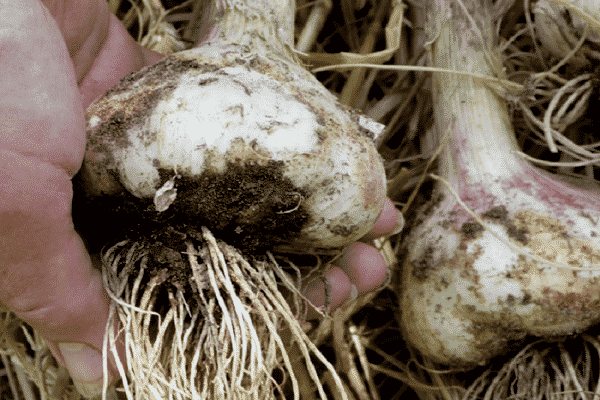

What is a one-tooth
A single-tooth (can also be called as sevok) is a planting material grown from seeds formed in arrows (aerial bulbs) discarded in the middle of summer. When they first heard about one-clove garlic, many ask what kind of variety it is. In reality, we are not talking about the variety, but about the seed that is obtained from any garlic that throws out arrows.
The denticles are small. Their shape is oval or round, sometimes resembling large peas. Falling into the ground in the fall, such a pea grows into a garlic head by the beginning of summer.


What is one-toothed garlic
For your information! Ideal for planting is considered sevok, which has a length of 2-2.5 cm. Exhibition samples of plants are grown from such planting material.
What is the difference from other types of planting material
The one-tooth differs from other types of planting material:
- frost resistance;
- immunity to most diseases and pests (even nematodes, which usually threaten the harvest of garlic, are not scary).
With the help of a single clove, they renew the variety of garlic, increase the yield, preserve its characteristics when it comes to an elite vegetable.
Harvesting and storage
Harvesting should be done after the tops turn yellow. For excavation, it is recommended to choose dry, preferably sunny, weather. Using a forks will reduce head damage.
Shake the dug out garlic from the ground and leave for 2 hours in the sun. This operation will disinfect the heads. Then spread the crop under a canopy or in a shed in a thin layer (about 5 cm) to dry the tops. Withstand 2 weeks.
Then cut off the roots at the bottom (leave 2-3 cm). Shorten the tops to 15–17 cm. Place in a basket or box with air holes. Store the crop in a dark place at room temperature.


The subtleties of spring planting
Spring garlic has recently been increasingly planted by vegetable growers. To get a high-quality harvest, amateur gardeners should use the following rules for the preparation of planting material and placement in open ground:
- Planting material is being prepared. This is a mandatory procedure that will help disinfect the cloves. First, the cloves are sorted out, freed from the husk, dry specimens are thrown away. A solution of copper sulfate is being prepared (1 tablespoon of the chemical is dissolved in ten liters of water). In this solution, the cloves must be held for 20 minutes. Rinse the cloves with water, dry slightly.
- Too dry heads can be restored by soaking them overnight in vermicompost. A solution is prepared in the same proportions as copper sulfate.
- Before planting, it is necessary to slightly moisten the prepared grooves, sprinkle them with wood ash. Ash is needed to prevent the occurrence of diseases, it also repels pests well.
- You should not plant family garlic where garlic, onions, root vegetables, potatoes previously grew. All of these crops thin the soil by depriving it of calcium. This will not have the best effect on the further formation of large single heads.
- You should not make a bed for garlic between trees and shrubs, they will shade the bed, interfering with the growth of the plant.
- The teeth are buried into the soil to a depth of about 5 cm. This should be done with the bottom down. A lot of space must be left between them, as several bulbs will form. It is good if the distance is about 23 cm. The next row is done by placing the cloves in a checkerboard pattern.
- The planted cloves of garlic are carefully sprinkled with earth, leveling the garden with a rake. If the planting was carried out before winter, the garden must be covered with mulch. Better to use sawdust. When planting cloves in spring, mulching is carried out between rows, the distance between them should be about 50 cm. You can spread straw there, it will help the soil not dry out, retain moisture, and prevent weeds.
- The higher the temperature of the soil and air, the faster you can see the first shoots of garlic. Usually, the first leaves appear at the end of May. Sometimes frosts suddenly hit in May, they can slightly freeze the leaves. If you notice that the leaves have turned yellow, don't worry. When the weather changes again, the culture will continue to grow.
Reviews of gardeners
Gardeners share their impressions of growing a plant with heads. A summer resident from the Moscow region says: “A neighbor shared her seed. We have been growing a vegetable using this method for several years. We are very satisfied: space is saved (we place the plants under the apple tree), the heads grow small, but sharp and fragrant. They do not freeze in winter (when planted in autumn).
It is a little difficult to undermine the plant during the growing season to remove the extreme heads. But the advantages are obvious: when planting, there is no need to fiddle and divide by teeth - time is saved. "
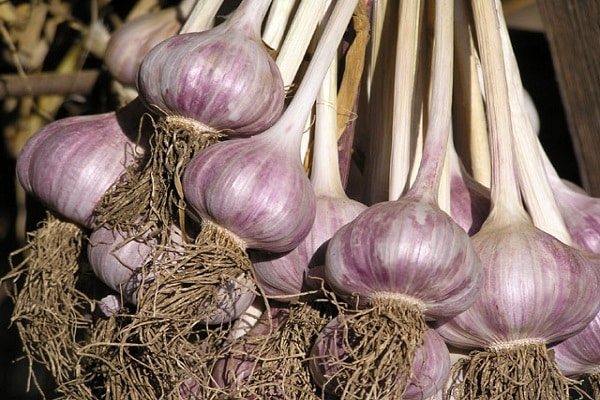

Why garlic heads don't get tied. Why isn't the garlic set?


In the spring we arrived at the garden and found that our garlic had grown very poorly. We planted three different “varieties”: one of our own and two others bought on the market. Great hopes were pinned on large garlic, which is usually sold by southerners. It had white onions and very large teeth. All three varieties were planted on the same bed, one after the other. The southern garlic died completely. Our own ascended, but rarely. Garlic bought from a pensioner proved to be the best. He was not so large, but lilac. Lilac garlic is said to keep well.
In early May, we planted a few more rows of our winter garlic, which lasted until spring. But when they began to harvest, they found that the new garlic did not form bulbs. One thick stem has grown, like a leek. Why did this happen? After all, we planted our own garlic, that is, the same as in the fall. In the autumn, normal bulbs have grown (pictured). Now it is clear that you will have to buy additional garlic for planting. Tell me which garlic to choose so that it hibernates well? N.P. Maslova, Nizhny Novgorod region
In our newspaper, we have already discussed the topic of poor wintering of garlic (Magic Garden No. 8 (185), 2010). The reason is that in the Nizhny Novgorod region in December there were frosts without snow. If the garlic was planted finely and not covered with tops or other mulching material on top, then in most cases it froze.
Now about the fact that different varieties of garlic overwintered in different ways. Large garlic purchased from the market was likely overfed with organic fertilizers. Under these conditions, he grows a very large bulb (gardeners say, "blown"). This is good for sale: garlic quickly gains weight and gets an excellent presentation. But it is not suitable for storage. These bulbs usually do not store well and overwinter poorly.
At the same time, examples are known when garlic brought from the south (but grown with normal doses of fertilizers) hibernates normally. Naturally, subject to the planting conditions: a depth of 5 cm and mulching the beds.
And, finally, the main question: why the bulbs of the garlic planted in spring did not start? Garlic varieties are divided into winter and spring varieties. There is almost no difference in taste. In appearance, one can distinguish: the spring has many small cloves and very thin, “papery” scales (in the winter they are dense).
The main difference is in the timing of planting. Winter garlic is planted two weeks before severe frosts (in the Middle Lane it is about mid-October). Spring garlic is planted in the spring as soon as the ground allows (usually in April). The fact is that for normal growth, winter garlic must go through a cooling period. Only in this case the bulb is tied. When planting in spring, and even at a later date (in May), the bulb does not form. The plant simply thickens the base of the stem. Such plants will not hibernate, they will simply rot. But they can be eaten and put in pickles in the same way as ordinary teeth.
If a lot of "stem" garlic has grown, try pickling it. To do this, chop finely and sprinkle with salt. You can simply leave the garlic in the garden and consume it as needed. Unlike “normal” garlic, the leaves of “spring” have not yet dried up. As long as they are green, the plant continues to grow.


